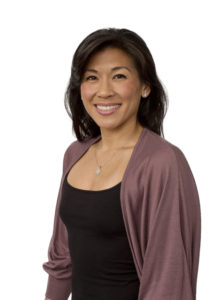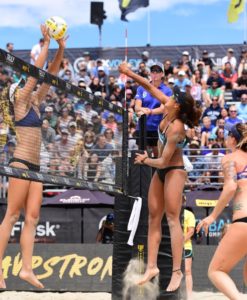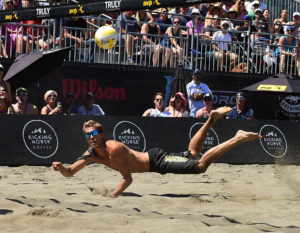Fitness, strength and athleticism are on full display every time the AVP pulls into a new city with a few dozen men and women vying for coveted beach volleyball titles in front of ever-increasing, sun-splashed crowds. Next week that stop is Austin, Texas, where the world’s best will put their bodies to the test on the sand, sometimes for two or three or even more matches in a day.
Keeping in shape for all that running, jumping and diving is paramount, and at the helm of all things in that area on tour is Medical Director Karena Wu. Karena took some time to talk to SportsMD.com this week as they move on from last week’s season-opening Huntington Beach Open to Austin (May 17-19) and through the eight-event slate.

SportsMD: What is the biggest misconception you come across with regard to beach volleyball athletes and training?
Karena Wu: That they are all super healthy! Many of the athletes play with injured parts and self manage their healthcare. Many do not have health insurance so would use the medical tent to help manage any issues. We are there to provide that service to a limited extent but also just to keep the athlete in play over that competition weekend. We support all athletes in their quest to make it to the championship round.
SMD: What are some of the more common injuries these athletes have? Is treatment different than say, for a basketball player or a soccer player because of the lateral movement needed in beach volleyball?
KW: Low back pain is very common due to hard packed sand (especially with any rain) or shallow sand. Shoulder and upper/middle back injuries are common because this is an overhead sport. They are constantly reaching with an outstretched arm for their serves, blocks and digs, and then generating power so it can really tax the rotator cuff musculature. Due to the dynamic nature of the terrain, they can tweak their body with rotational forces that can impact the spinal column, e.g. going for a dig and controlling the rolling with the scramble to get back up, or injure the knee/ankle e.g. torque the knee = ACL/meniscal/MCL tears or high ankle sprains.
Treatment can require more stability training or bracing, e.g. taping because with any injury that causes hypermobility, between the excess motion in the joint and the dynamic terrain, the joint will need more support in order for the athlete to continue to bear weight and power through the joint as well as reduce their perception of pain.
SMD: For those who play recreationally, what are some tips for warmup to prevent injury?
KW: Dynamic stretching in both straight planes e.g. forward/back/side to side as well as multiplanar motions e.g. rotations. Activating the rotator cuff musculature for the shoulders can help minimize rotator cuff strain with the constant overhead motions. Core activation is also crucial to help stabilize the lumbopelvic region which is the powerhouse of the body which then helps power the limbs.

SMD: Are there different training and injury prevention programs that beach volleyball players go through as opposed to those who play indoors or on a hard surface?
KW: The sand really taxes the system as it requires more stability and force to generate any lift for serves, blocks or getting the dig. Strength and endurance training are requirements for both indoor and beach. Agility drills, power moves and cardiovascular endurance on soft sand are required for beach so that the body is conditioned to move optimally on the dynamic surface. Feet and calves get taxed on athletes moving from indoors to outdoors. You forget how many bones and muscles are in the feet and they are all working hard to push the body through the sand and lift up out of it! Both big e.g. hip and small e.g. foot intrinsic muscles are used.
SMD: Who are some of the athletes whose training regimen surprises you and why?
KW: Last year, we kept an athlete with shoulder issues in play by doing the basic, beginner isometric exercises which activate the muscle, reduce perception of pain and help maintain stability in the joint. Oftentimes I find that the simple stability exercises are needed for these power and agility athletes because they are all giving it their 120% and using the big muscle groups, but the little stabilizers are needed in order for the rest of the body to be able to do these movement. Stabilizers are smaller and deeper and can get weaker faster because the larger muscles are easier to activate.
SMD: Is there a big discrepancy in how women pros train vs men?
KW: Not that I have seen. I’ve watched video of some of the pro females and their are lifting MASSIVE amounts of weight!

SMD: One of the biggest challenges for beach volleyball is exposure to sun. Are there key tips to remind either the AVP player or someone playing for fun to remember that are often forgotten by either or both?
KW: Sunscreen, hat/visors, sunglasses and wearing long sleeved clothing. You cannot avoid the sun exposure. People love the look of a tan, but the second you get the questionable skin mole or ‘spot’ it is too late. So, use and reapplication of sunscreen is a must but the best protection is actually staying covered and ducking into the shade immediately after play.
SMD: Lastly, for the time you have been involved in the sport, what has changed the most and the least from a fitness and preparedness perspective?
KW: Once the medical tent limited use of the volunteer providers, I have seen that the athletes are better at self management. They bring their instruments for self massage, taping or icing and will work out their own body kinks. Also, the psychology of the athlete changed where they didn’t feel the need to rely on the medical tent because the medical tent should really only be treating truly injured athletes, not just for body work maintenance e.g. flushes/massages.
What has minimally changed is the pre-conditioning. I rarely see an athlete come to the pro circuit without being fully conditioned. They would never make it through the qualifiers and the main draw. So, most are well conditioned and well educated on the needs for this sport and that has been a good constant.
Cover Image: 2019 AVP Huntington Beach 2019 (Credit: Robert Beck)

